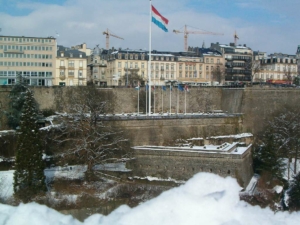Luxembourg City, the capital of Luxembourg, is a charming and historic city with a wide range of things to do in Luxembourg City. From its medieval fortifications to its world-class museums, there is no shortage of things to see and do in this vibrant city.
Whether you’re interested in history, culture, food, or simply enjoying a beautiful setting, Luxembourg City has something for you. And because it’s so compact, you can easily see and do a lot in a short amount of time.
But don’t just take my word for it. Here are 12 of the best things to do in Luxembourg City. Read on to discover the most beautiful places in Luxembourg City and plan your unforgettable trip today!
Table of Contents
Casemates du Bock
Casemates du Bock are one of Luxembourg City’s first attractions that come to mind when you think of Luxembourg City. Besides playing a big role in Luxembourg’s history, it’s also a UNESCO World Heritage Site. Luxembourg’s intricate passages and fortifications are nestled within the ancient castle’s rocky foundation, where they’ve defended the city for centuries. Our article will cover the fascinating history of the Casemates du Bock and the thrilling experiences they offer.
Unraveling the Past: The Significance of Casemates du Bock
This underground marvel has protected Luxembourg through countless invasions and conflicts. It can’t be overstated how important these Casemates du Bock are to us. This network of passages goes beyond artillery slots and barracks; it’s a testament to Luxembourg’s resilience. The tunnels were not just used for artillery slots and barracks but were also used as workshops, bakeries, and bomb shelters during World War II. Throughout history, the Casemates have been crucial to strategy.
A Glimpse into History
There’s still a remnant of the castle up above in the Casemates du Bock, even though it’s in ruins today. Visitors can see part of this 23-kilometer-long labyrinth of tunnels. They’re like walking back in time, so you get a feel for it. It’s cool to see how people once lived in these tunnels, their strategies, and the way they lived.
The breath-taking views
In addition to being historically significant, Casemates du Bock offer stunning views of the surrounding area. Atop the valley, the Casemates offer the best view. From this historic site, you can take in Luxemburg City and the picturesque valley below. It’s a photographer’s dream, with stunning views that won’t let you down.
Plan Your Visit
If you’re planning a trip to Luxembourg City, a visit to the Casemates du Bock should be at the top of your itinerary. To make the most of your experience, consider the following tips:
- Timing is everything.
To avoid crowds and truly savor the atmosphere, plan your visit during the early morning or late afternoon. The gentle lighting at these times enhances the ambiance, making it an ideal period for capturing photographs.
- Wear comfortable footwear.
You’ll be walking a lot when you explore the casemates, so wear comfortable shoes. Tunnels can be uneven, so you’ll want to feel comfortable.
- Things to do in Luxembourg city-Guided Tours
Take a guided tour to learn more about the site’s history. Knowledgeable guides can provide insights and anecdotes that will enrich your experience.
- Souvenirs and Gifts
Don’t forget to check out the gift shops for souvenirs. You’ll find lots of mementos and gifts to commemorate your visit to this UNESCO World Heritage Site.
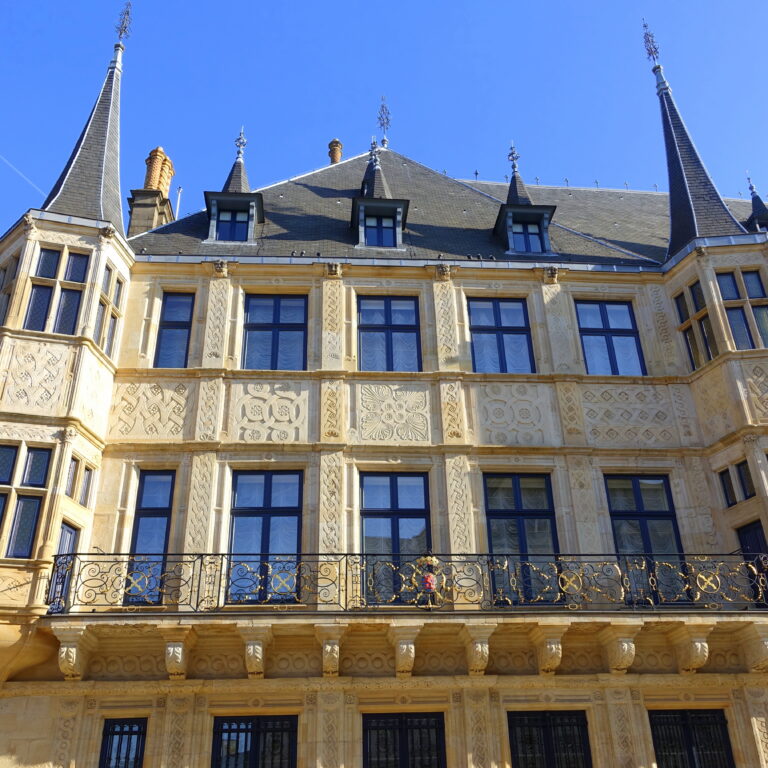
Grand Ducal Palace
After visiting the casemates, it is now time to explore things to do in Luxembourg City, starting with a visit to the Grand Ducal Palace. As the official residence of the Grand Duke of Luxembourg, this architectural gem stands as a testament to the nation’s grandeur. In this article, we’ll take you on a journey through its historic halls and guide you on how to make the most of your visit.
Unveiling the Grand Ducal Palace
The Grand Ducal Palace, a masterpiece of Renaissance architecture, stands proudly in the heart of Luxembourg City, just a stone’s throw away from the Casemates du Bock and Old Town. In the 16th century, this magnificent structure was built. It’s been renovated extensively; it still looks great!
What makes the Grand Ducal Palace a must-visit?
Architectural Marvel: Intricate design and historical significance make the Grand Ducal Palace a must-see attraction for everyone visiting Luxembourg City.
Artistic Treasures: There are a ton of paintings, sculptures, and furniture inside this palace, which offers a glimpse into Luxembourg’s artistic heritage.
Exploring the Grand Ducal Palace
During the summer months, the Grand Ducal Palace is open to the public, especially from July to August. To explore it in full, take a guided tour in English, French, or German.
Things to do in Luxembourg City: Booking your tour
Book your tour at the Luxembourg City Tourist Office or on the Grand Ducal Palace’s official website. Tickets usually sell out fast, so book early.
Essential Tips for Your Grand Ducal Palace Experience
- Book in advance: There’s high demand for tours, so it’s best to book in advance.
- Guided tours last about an hour. They’ll give you a comprehensive history and significance of the palace.
- You should dress appropriately when visiting the Palace, since it still serves as a royal residence. Be respectful, and also fully embrace the regal atmosphere while you’re there.
- Photography Restrictions: Keep in mind that photography is not permitted inside the palace. This rule helps preserve the palace’s treasures for future generations.
A Glimpse from the Outside
The Palace is gorgeous, even if you can’t go into the inner sanctums, but watching it from the outside is breathtaking. At night, the palace illuminates Luxembourg City beautifully, giving it a mesmerizing glow. Take a moment to take in the breath-taking views it provides, capturing the essence of this regal place.
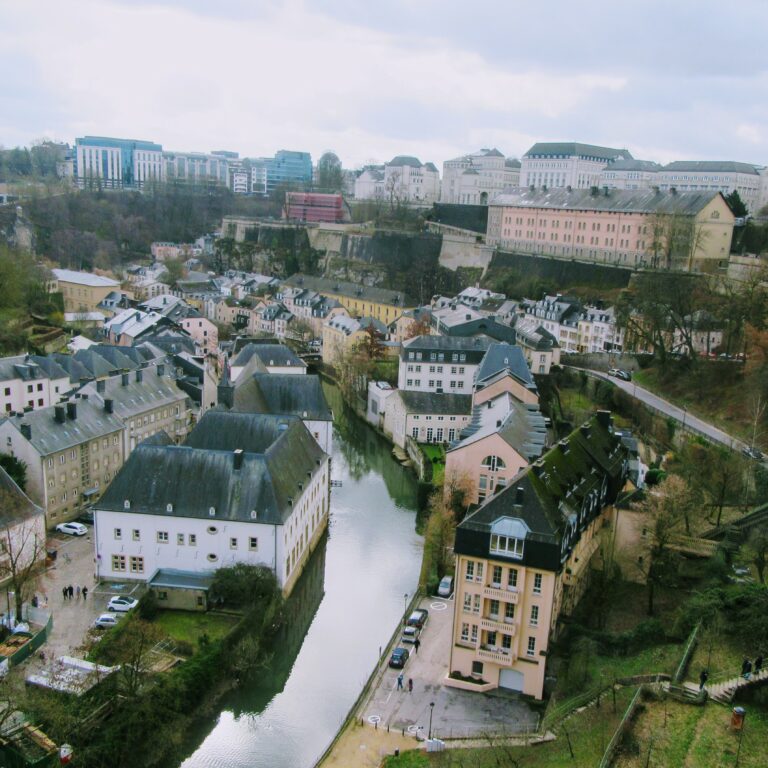
Discovering the Chemin de la Corniche
Things to do in Luxembourg City. Winding its way along the Bock’s sides, this picturesque pathway treats visitors to breathtaking vistas of the Grund and the Alzette Valley. Your journey commences in the vicinity of the iconic St. Michael’s Church and the Schlassbréck bridge, guiding you along the southern route of the Bock promontory. Your exploration reaches its zenith near Rue du St. Esprit and the National Archives building.
A Glimpse into History
In the 1870s, navigating this route was a formidable task, given that stairs served as the primary means of passage. Yet, as the years progressed and the fortresses were dismantled, the path underwent substantial enhancements. The formerly steep sections were leveled, rendering the journey much more accessible to all.
Scenic Overlook
This is one of the most beautiful things to do in Luxembourg City I’ve ever experienced. Overlooking the Alzette River and the charming town known as Grund, it’s a unique experience. A public elevator is available to take you down to its streets so you can explore the Grund further. The Abbey across the river adds to its charm, too. In addition to its stunning views, the Grund has the Natural History Museum and plenty of shops and restaurants along the Alzette.
Things to do in Luxembourg City-Why You Should Visit
The renowned Luxembourg writer, Batty Weber, once said that this is “the most beautiful balcony in Europe,” and with good reason. This location truly stands as one of the most picturesque spots in the city. Whether you’re a nature enthusiast, a history buff, or simply someone seeking an enjoyable stroll, Chemin de la Corniche has something for everyone. With its stunning vistas, rich history, and serene ambiance, it’s a place that will likely beckon you to return multiple times during your visit.
To sum it up, Chemin de la Corniche is a hidden gem in the heart of Luxembourg that promises a memorable experience. The view is incredible, the history is important, and the writer endorses it. If you’re in Luxembourg, make sure to see the stunning views it offers.

Notre-Dame Cathedral
The Notre-Dame Cathedral in Luxembourg City is also something you won’t miss when it comes to things to do in Luxembourg City. It traces its roots back to the 17th century and is a splendid example of Gothic style. In the Roman Catholic Archdiocese of Luxembourg, it serves as a spiritual heart dedicated to the Virgin Mary. The temple is infused with a sense of mystique and devotion.
Why should you embark on a journey?
The Notre-Dame Cathedral beckons, an enchanting allure for every traveler setting foot in Luxembourg City. Within its hallowed walls, Gothic architecture unfolds its intricate tapestry, and a treasure trove of remarkable artistry awaits your gaze. Admire the kaleidoscope of stained glass windows, the masterful sculptures, and the evocative paintings that grace this sanctuary.
Furthermore, this cathedral serves as the final resting place for luminaries of the Luxembourgish royal family, including the revered Grand Duke Jean and the beloved Grand Duchess Charlotte.
Things to do in Luxembourg City-Navigating your visit.
The Notre-Dame Cathedral extends a warm welcome to visitors, keeping its doors open seven days a week. Whether you are a devout Catholic, a curious tourist, or simply seeking a peaceful place to reflect, the cathedral is a welcoming and inclusive space for all.
Upon entering the cathedral, you are immediately struck by its soaring Gothic architecture. The high ceilings, stained glass windows, and intricate stonework create a sense of awe and wonder.
As you explore the cathedral, be sure to take note of the many works of art that adorn its walls. The stained glass windows are particularly impressive, depicting scenes from the Bible and the lives of saints. Be sure to check out the rose window in the transept, which is one of the largest in Europe.
For a more in-depth experience, consider embarking on a guided tour, available in English, French, and German. These immersive tours offer insights into the cathedral’s rich history and typically span an hour of exploration.
How to make the most of the Cathedral
- Embrace respectful attire, as the Notre-Dame Cathedral is a sacred site deserving of reverence.
- Capture the breathtaking moments with your camera, but do so with respect for the faithful who seek solace within.
- Plan your visit thoughtfully, as the summer months can draw crowds; mornings and late afternoons offer a more serene atmosphere for your exploration.
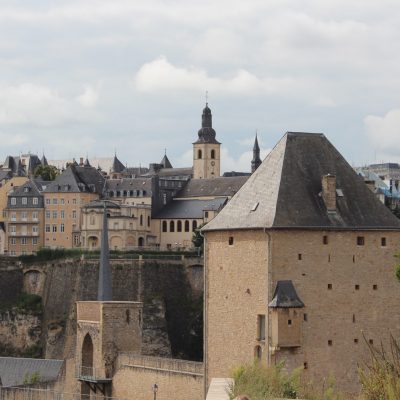
Luxembourg City’s old town
When you think of European charm and history, the Old Town of Luxembourg City, with its plethora of things to do in Luxembourg City, immediately comes to mind.
This UNESCO World Heritage Site is a mesmerizing neighborhood characterized by its cobbled streets, medieval architecture, and vibrant cafes and restaurants.
Why visit the old town?
It’s a place to step back in time and lose yourself in Luxembourg City’s unique atmosphere. Here’s why you should go there:
A Stroll Through History
A stroll through Luxembourg’s labyrinthine alleys is like stepping back in time, with its historic architecture and preserved medieval streets.
Culinary Delights
It’s not just about history; it’s also about food. The area boasts a wide range of dining options, from traditional Luxembourgish cuisine to international flavors. Try one of the charming cafes or restaurants along its streets for a drink or meal.
Tips for Exploring the Old Town
- Wear comfortable shoes. You’ll be walking a lot on cobbled streets, so wear comfortable shoes.
- Sun Protection: During the summer, the Old Town can get quite hot. Don’t forget to bring a hat and sunscreen to stay comfortable while exploring.
- Walk Carefully: The cobbled streets can be uneven, so watch your step.
Open Around the Clock: The Old Town is accessible 24/7, seven days a week. You can explore its beauty at any time that suits you.
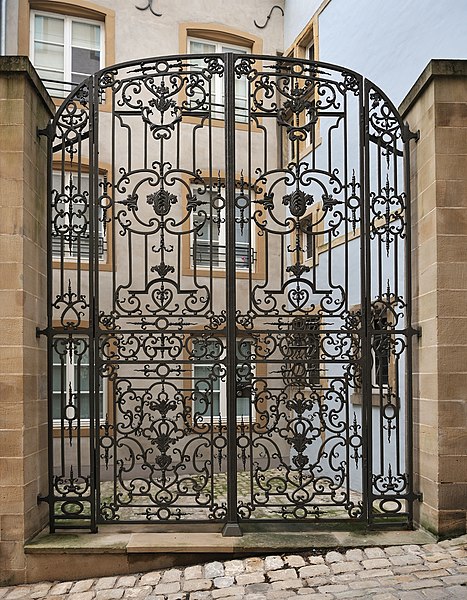
National Museum of History and Art
A treasure trove of history and culture is nestled in Luxembourg City at the National Museum of History and Art (Musée National d’Histoire et d’Art). A diverse and extensive collection of artifacts and artworks narrates Luxembourg’s past and present in this grand institution, which is Luxembourg’s largest museum. Featuring a captivating journey through time and heritage, the National Museum of History and Art is a must-see.
Exploring Luxembourg’s Past
Any traveler coming to Luxembourg City should check out the National Museum of History and Art. In this cultural gem, you can explore the country’s fascinating history and culture, tracing its roots from Roman times to today.
A Glimpse into the Past
There’s a ton of interesting stuff in the museum, from priceless archaeological finds to intricate coins and medals, from formidable weapons and armor to exquisite furniture and paintings, and the museum’s exhibits tell a fascinating story about the nation.
Interactive Learning
Its interactive exhibits bring Luxembourg’s history to life, making learning fun and engaging for visitors of all ages.
Marveling at Roman Mosaics
Among the museum’s many treasures, the Roman mosaics are true marvels. Discovered during the 1950s, these mosaics were uncovered during the construction of a parking garage. They transport visitors to ancient times, depicting scenes from Roman mythology and culture. Remarkably well preserved, these mosaics are considered some of the finest examples in the world.
The Enigma of the Golden Lady
This gold statuette was found in a tomb near Echternach in the 1960s and is believed to represent a Celtic goddess. Another jewel in the museum’s crown is the Golden Lady statuette. The significance of this discovery cannot be overstated, since it ranks among Luxembourg’s most remarkable archaeological discoveries.
A Place for All Ages
Aside from being a repository of artifacts, the National Museum of History and Art is also a fascinating experience for everyone. You’ll leave an indelible mark on everyone who walks through its halls because of its blend of education and entertainment.
Things to do in Luxembourg City: Useful infos about the museum
Opening Hours
The museum welcomes visitors from Tuesday to Sunday, from 10:00 AM to 6:00 PM, allowing ample time to immerse oneself in the rich history on display.
Guided Tours
A guided tour of approximately one hour lasts and provides valuable insights into the exhibits and history of the museum.
Accessibility
Every visitor, including those with disabilities, can explore the museum’s treasures without hindrance.
Souvenirs and Refreshments
You can get souvenirs and enjoy a well-deserved break at the museum’s café and gift shop after your tour.
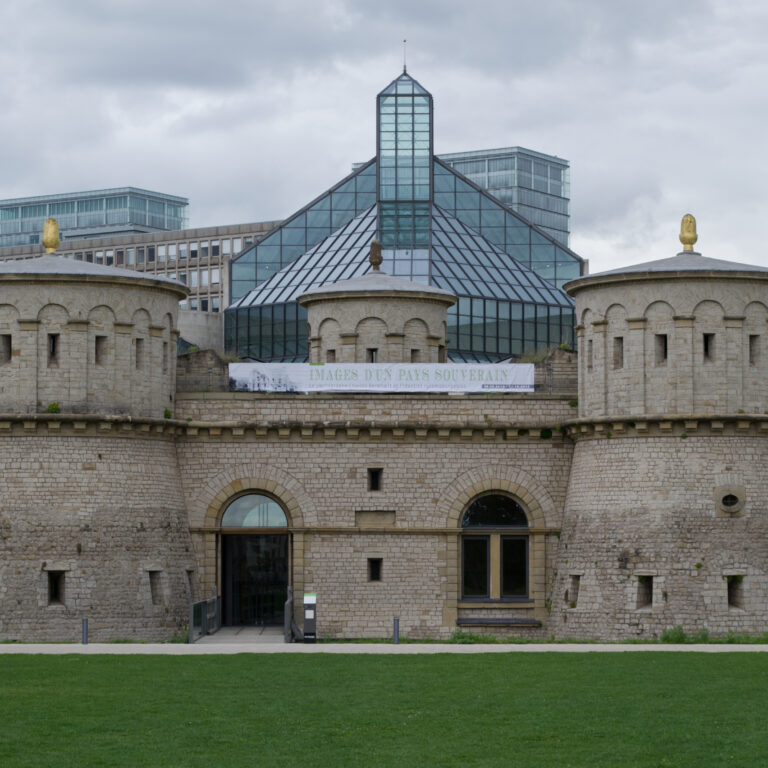
Musée Dräi Eechelen
The Musée Dräi Eechelen: Fortress, History, and Identities is housed within the meticulously restored keep of fort Thüngen, a remarkable historical edifice that encapsulates centuries of Luxembourg’s heritage.
Discovering Luxembourg’s Past: A Fascinating Journey
This extraordinary museum offers visitors a captivating voyage through time, immersing them in different eras of the fortress within its casemates while shedding light on its profound impact on the country’s history.
Unveiling the Middle Ages
Experience history like never before, beginning with the Middle Ages, when Luxembourg fell under the rule of the Burgundians in 1443. Explore fascinating accounts of that era, filled with artifacts and records.
From Antiquity to Modernity
As the tour continues through the ages, you’ll see how the fortress influenced Luxembourg’s evolution and eventually led to the iconic Adolphe Bridge in 1903.
A Treasure Trove of Artifacts
A big draw of the museum is its extensive collection of over 600 objects and original documents, many of which have never been seen before, providing a unique opportunity to see Luxembourg’s diverse heritage.
Journey through Time via Photographs
There’s a special room inside the museum with carefully curated historical photos that give you a chance to delve into the fortress’ history right before and after it was destroyed.
The building’s remarkable history
Not only does the Musée Dräi Eechelen narrate the history of the fortress itself, but it also embodies a crucial part of the permanent exhibition. The remarkable underground galleries and mines, preserved in their 1836–1837 condition, provide a fascinating window into the past.
Virtual Exploration
Experience the fortress’s history through an interactive virtual platform. Explore key themes with an interactive database and audio-visuals in the multimedia room.
Guided Insights
Audio guides provide detailed explanations of numerous objects in multiple languages, including French, English, German, and Luxembourgish.
Luxemburg 4D: A Cinematic Insight
The museum’s auditorium shows the movie Luxembourg 4D, which explores Luxembourg’s political, economic, social, and cultural development throughout the 20th century.
Musée Dräi Eechelen isn’t just a museum; it’s a time machine that lets people see Luxembourg’s rich history and fascinating stories throughout the ages. You have to visit this remarkable institution if you’re a history buff or just curious about the past of this beautiful country.

Luxembourg American Cemetery
When it comes to the Luxembourg American Cemetery, you’re not just stepping onto hallowed ground; you’re entering a solemn sanctuary that pays homage to the brave men and women who sacrificed everything during the pivotal moments of World War II. Spread across a vast expanse of 17 acres, meticulously maintained lawns embrace the memory-laden 33.5 acres of surrounding woods. Let’s take a closer look at this remarkable memorial site, ensuring you have all the vital information you need.
The Visitor Center: Your Gateway to History
On your left, as you approach the front gates, is the visitor center. You can get a lot of information and grab brochures about the cemetery’s significance. It’s a great place to start, giving you essential insights and advice.
The Memorial Chapel: A Symbol of Remembrance
The memorial chapel is immediately visible when you enter the gates. In front of you, you’ll see massive bronze doors with cartouches depicting various military “virtues.” You’ll be captivated by the bright mosaic ceiling and vibrant stained glass windows that proudly display the Army insignia. Those elements serve as a poignant tribute to those who lay there forever.
Pylons of Remembrance
Descending to the lower level of the terrace, two monumental pylons stand facing each other, framing a heartfelt quote by Dwight D. Eisenhower that honors the sacrifices made by military service members. These pylons do more than just commemorate history; they showcase the battle movements in the Western European Operations on the right and those related to the Battle of the Bulge on the left. The reverse of these maps bears the names of 371 brave individuals who remain missing in action. Twenty-three bronze rosettes signify the service members who have been recovered and now rest in known graves.
The Serenity of the Cemetery
The cemetery itself gently slopes away from the terrace and provides a final resting place for 5,070 service members. Many of these heroes gave their lives during the Battle of the Bulge and the advance to the Rhine River. The design of the cemetery is a masterpiece—a softly curving fan shape comprising nine sections. These sections are thoughtfully interspersed with four fountains, majestic trees, and expansive rose and rhododendron beds, creating a serene and fitting tribute to those who made the ultimate sacrifice for their country.
A Testament to History
This sacred ground, established on December 29, 1944, holds a unique place in history. The 609th Quartermaster Company of the U.S. Third Army established it during one of the most critical battles of World War II, the Ardennes Offensive.
Luxembourg played a pivotal role as the headquarters for General George S. Patton’s U.S. Third Army. The cemetery is the eternal resting place of General Patton, one of the iconic figures of the war.
As you explore this site, you’ll be tracing the footsteps of history and paying your respects to the heroes who shaped it.
So, the Luxembourg American Cemetery isn’t just a place to remember; it’s a living testament to all the sacrifices people made during WWII. You’ll connect with history and honor the memories of those who gave their all when you visit this site.
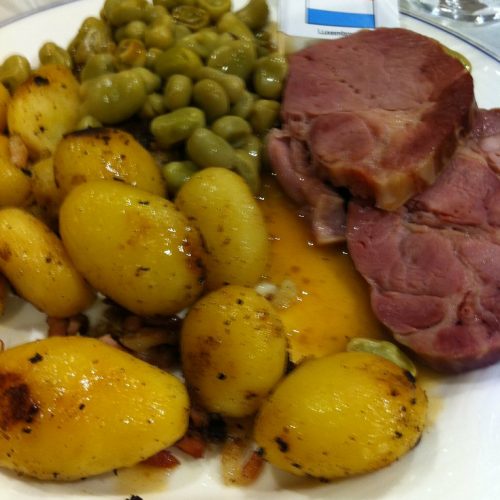
Try Luxembourgish food.
Luxembourg has a rich and diverse culinary tradition, influenced by its neighboring countries of France, Germany, and Belgium. Some popular Luxembourgish dishes include:
- A traditional Luxembourg dish, Judd mat Gaardebounen, is smoked pork neck with broad beans.
- Kniddelen are potatoes, eggs, and flour dumplings typically served with gravy, sauerkraut, or mushroom sauce.
- Rieslingspaschtéit: A meat pie filled with pork, veal, and chicken, vegetables, and spices. It’s usually served with potato salad or applesauce.
- Friture de la Moselle: Fried fish from the Moselle River This dish is typically served with a side of French fries or potato salad.
- Quetschentaart: Luxembourgers love plum tart, which is often served with coffee or tea.
Where can I eat Luxembourgisch food?
Restaurant Um Dierfgen
With two levels and a sunlit terrace, this restaurant offers a welcoming atmosphere with uncomplicated interior design and rustic wooden tables. It’s known for its regional cuisine.
Along with dumplings and sausages in mustard sauce, the menu also offers feierstengszalot, thin slices of beef served with salad and potatoes, as well as roasted ham and tête de veau, calf head dishes. In addition to steak tartare, rabbit in a mustard sauce, and seafood, customers can savor a number of other local specialties.
Vegetarians can get kniddelen without meat.
Bistro de la Presse
Visit this delightful bistro adorned with vintage photographs, and don’t let the whimsical puppet decorations hanging from the ceiling deter you.
You can eat Luxembourgish dumplings with bacon and cream here, or raclette, a luscious melted cheese that you can savor.
Furthermore, the menu boasts delectable options like sausage with mustard sauce and a Luxembourgish platter bursting with local cheese and meats. It’s even better because you can enjoy your meal while watching the Grand Ducal Palace.
Am Tiirmschen
This establishment near the Corniche offers a welcoming setting, featuring a cozy sheltered terrace and a rustic interior adorned with exposed stonework, timber-framed ceilings, and comfortable wicker chairs.
It’s an ideal place to savor traditional Luxembourgish dishes such as bouneschlupp mat mettwurst, a hearty bean soup with smoked sausage, choucroute a la Luxembourgeoise, a flavorful combination of pork, bacon, and smoked sausage (available from September to April), and a diverse selection of kniddelen.
Additionally, you can indulge in Judd mat gaardebounen and sausage served with a delectable mustard sauce. To kick off your dining experience, they also offer the renowned local favorite, gromperekichelcher, potato cakes.
The restaurant is closed until january 2024.
The Pfaffenthal Lift
In the heart of Luxembourg City, among the fascinating things to do in Luxembourg City, lies the Pfaffenthal Lift, a transparent elevator bridging the exalted upper realms and the lower precincts. Nestled within the enchanting Pfaffenthal District, which finds its serenity on the meandering banks of the Alzette River.
The allure of the elevator, a symphony of vistas and experiences, captivates the discerning traveler. A sweeping vista opens up, showing off the majestic Notre-Dame Cathedral, the majestic Grand Ducal Palace, and the historic Bock Casemates.
Pfaffenthal District is filled with art galleries, boutiques that ooze personality, and epicurean treasures that will tantalize your taste buds.
Why does one embark on the pilgrimage to the Pfaffenthal Lift?
There exist myriad motives that make the sojourn to the Pfaffenthal Lift a compelling endeavor:
Views of the city that are truly transcendent: The Lift has the best panoramas. A visual tapestry unfolds as you climb the elevator, showing off the Grand Ducal Palace, Notre-Dame Cathedral, and Bock Casemates.
There’s just something so wonderful about taking the Pfaffenthal Lift. This idyllic neighborhood is full of art galleries, enchanting boutiques, and gourmet havens that will satisfy all your culinary needs.
A Triumph of Architectural Uniqueness: The Lift is a triumph of architectural ingenuity. A resplendent glass capsule, it stands in stark juxtaposition to the medieval architectural heritage that envelops it.
For those contemplating a visit to this sublime contraption, here are some nuggets of wisdom:
- The Lift extends its welcome from the earliest light of dawn at 5:45 AM until the witching hour at 1:00 AM, all seven days of the week.
- Admission is graciously unburdened by cost, offering free passage to all who seek it.
- The elevator stands as a paragon of accessibility, thoughtfully designed to accommodate those with mobility challenges.
- While crowds may throng, a wise traveler, seeking a more tranquil experience, chooses to ascend during the quieter moments, evading the crowds’ clamor.

Visit the Golden Lady
Gëlle Fra, a nickname affectionately given to the Monument of Remembrance, a monument in the center of Luxembourg, Claus Cito came up with this memorial masterpiece to honor the valiant Luxembourgish soldiers who selflessly enlisted in the French army during World War I, a tumultuous era of the war. As it evolved over time, it became a symbol of defiance against the sinister yoke of Nazi hegemony, transcending its original purpose to serve as a somber reminder of war’s universal costs.
In the year 1920, the National Monument Commission initiated a competition with the noble objective of erecting a monument dedicated to the valiant Luxembourgish soldiers who, as volunteers, gallantly served in the ranks of the French army during the harrowing throes of World War I. Among the 18 remarkable submissions, the design put forth by Claus Cito, eloquently christened as the ‘Queen of Freedom’ or ‘Friddenskinnigin’ in the native Luxembourgish tongue, emerged as the chosen one.
The foundational structure of this poignant creation comprises two resplendent male bronze figures, one poignantly portraying a fallen soldier and the other embodying his bereaved compatriot in deep mourning. At the heart of this commemorative masterpiece stands a towering obelisk, soaring to a majestic height of 21 meters, crowned by the radiant gilded bronze effigy of the Golden Lady.
A hallowed monument representing the very essence of our nation’s hard-fought independence was erected in May 1923. It became a target in May 1940, when the shadows of the Nazi occupation descended over the land.
A steamroller callously toppled the statue in October of 1940, amidst the impassioned protests of students and the somber echo of their voices.

Luxembourg City Museum
Nestled in the heart of the capital, the Lëtzebuerg City Museum is a captivating journey through over a thousand years of Luxembourg’s storied history. This compelling narrative begins with the mesmerizing “The Luxembourg Story,” a permanent exhibition that breathes life into the city’s evolution. Immerse yourself in the past as you encounter an array of original artifacts, intricate models, and multimedia animations that vividly depict the historical tapestry of this enchanting city.
Rediscovering Luxembourg’s Roots
“The Luxembourg Story” is a captivating exhibition at the Luxembourg City Museum that weaves together the story of Luxembourg’s history. Take an enthralling journey through history with countless original artifacts, models, and multimedia animations.
UNESCO Visitor Centre: A Gateway to Heritage
This historic theme is seamlessly woven into the new UNESCO Visitor Center at the museum, so you get to see both sides of the story. Learn more about Luxembourg’s significance on the world stage at this center, which offers a deeper understanding of the city’s rich history. Discover the connections that make Luxembourg’s heritage so special, thanks to its UNESCO heritage.
A Tribute to Global Heritage
You don’t just enter a museum when you walk into the UNESCO Visitor Center. It’s an incredible place where Luxembourg’s history meets the global fabric of heritage. This center is a testament to the city’s global influence.
Beyond the Past: Temporary Exhibitions
The Lëtzebuerg City Museum offers more than a glimpse into the past. With two additional floors dedicated to temporary exhibitions, you’ll always find something new. The dynamic exhibitions cover a wide range of topics, so you’ll have something unique to see.
A Contemporary Touch
There’s always something new to explore on these floors, even though the museum’s heart lies in its historical roots. They’ve got lots of fun and interesting temporary exhibits to choose from. From art exhibitions to cultural showcases, they’re awesome.
A historic setting
Each of the four buildings houses a unique story about the Luxembourg City Museum. It’s hard to ignore Luxembourg’s rich history when you see these architectural gems dating back to the 17th and 19th centuries. They’re even built on medieval foundations, which makes them even more historic.
A Unique Elevating Experience
Your visit is going to be amazing because the glass lift transports up to 65 people along the museum’s ancient walls at once. It’s a journey that lets you touch the past while embracing the present. You’ll see panoramic views of the city’s historic surroundings, creating a truly immersive experience.
I’d say one of the great things to do in Luxembourg City is the Luxembourg City Museum. It is a fascinating place that takes you through Luxembourg’s rich history. There’s something for everyone here, from “The Luxembourg Story” to the UNESCO Visitor Centre and dynamic temporary shows. There’s a unique blend of past and present here, creating an unforgettable experience for everyone who visits this museum, set in historic buildings, including a stunning glass lift.

FAQ
1. What are some of the best things to see and do in Luxembourg City?
If you’re visiting Luxembourg City, you’ll find plenty of attractions to explore. Some of the must-visit places include the magnificent Luxembourg Cathedral, the charming Old Town, and the impressive Grand Ducal Palace. You can also take a leisurely walking tour around the city center to discover its hidden gems.
2. What are the top tourist attractions in Luxembourg City?
Luxembourg City offers a range of popular tourist attractions. In addition to the Cathedral and the Grand Ducal Palace, make sure to check out the stunning views from Chemin de la Corniche, often referred to as “Europe’s most beautiful balcony.” The Luxembourg City History Museum is also worth a visit for those interested in learning about the city’s rich history.
3. How can I make the most of a day trip to Luxembourg City?
If you only have one day to explore things to do in Luxembourg City, start by visiting the Old Town, where you’ll find many historical landmarks and picturesque streets. From there, make your way to the Grand Ducal Palace and take a stroll along Chemin de la Corniche to enjoy the breathtaking views. Don’t forget to immerse yourself in the city’s culture by trying some local cuisine at one of the charming restaurants in the city center.
4. Are there any guided tours available in Luxembourg City?
Absolutely! Guided tours are a great way to discover all the hidden treasures of Luxembourg City. There are various tours available, including walking tours that cover the city’s main attractions and historical sites. Joining a guided tour can provide you with valuable insights and interesting stories about the city’s past and present.
5. What are some fun things to do in Luxembourg City?
If you’re looking for some fun activities in Luxembourg City, consider taking a boat tour on the Alzette River or exploring the underground casemates, which are a network of tunnels used for defensive purposes. You can also enjoy a leisurely picnic in one of the city’s beautiful parks, such as Park Dräi Eechelen.
6. Can I visit the Grand Duke of Luxembourg?
While it’s not possible to visit the Grand Duke of Luxembourg’s private residence, the Grand Ducal Palace is open to the public during the summer months. You can take a guided tour of the palace and admire its stunning architecture and opulent interiors.
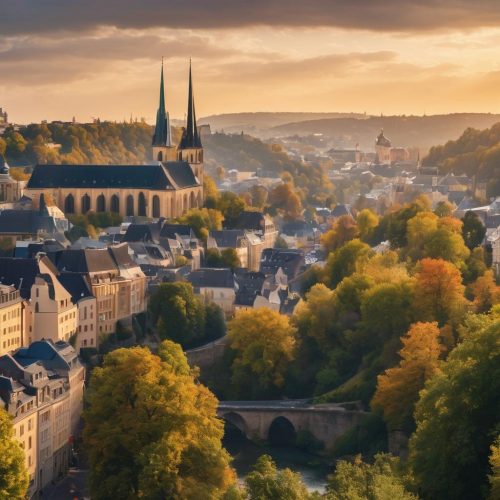
Things to do in Luxembourg City-Visit us
Luxembourg City is a charming and historic city with something to offer everyone. From its stunning views and medieval architecture to its vibrant culture and delicious food, there is no shortage of reasons to visit.
If you are looking for a unique and unforgettable travel experience, I encourage you to consider visiting Luxembourg City. Here are just a few of the top things you can see and do during your visit:
- Explore the Casemates du Bock, a vast network of underground tunnels and chambers that were used as fortifications for centuries.
- Visit the Grand Ducal Palace, the official residence of the Grand Duke of Luxembourg.
- Take a walk along the Chemin de la Corniche, a walkway that offers stunning views of the city.
- Visit the Notre-Dame Cathedral, a beautiful Gothic cathedral that is home to a number of important works of art.
- Visit the Luxembourg City History Museum to learn about the city’s rich history and culture.
- Try Luxembourgish food, such as Judd mat Gaardebounen (smoked pork neck with broad beans) and Rieslingspaschtéit (a meat pie filled with pork, veal, and chicken).
- Visit the Pfaffenthal Lift, a glass elevator that offers stunning views of the city.
No matter what your interests are, you are sure to find something to love in Luxembourg City. I encourage you to start planning your trip today!

